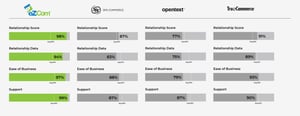
Looking for ways to increase customer loyalty? You should be—repeat business is a formula for success. It’s easier to follow up a sale with another one—it’s getting the first purchase that’s the biggest challenge. But today’s consumers have more options than ever before, suppliers are often responsible for shipping to them directly, and building a base of frequent buyers requires careful attention. For brands and retailers, finding ways to increase customer loyalty should be a key initiative.
Why is it so important? Consider these numbers from Small Biz Genius:- 82% of companies agree that retention is cheaper than acquisition.
- 75% of consumers say they favor companies that offer rewards.
- 56% of customers stay loyal to brands which “get them.”65% of a company’s business comes from existing customers.
- 5% boosts in customer retention increase profits by 25% to 95%.
- 58% of companies pursue personalization strategies for customer retention.
Clearly, customer loyalty is a worthy goal and developing it will be rewarding. The challenge, as in most instances, lies in the execution.
So let’s start with some basics—here are four proven ways to increase customer loyalty.
Ask for customer feedback.
Don’t have as many repeat buyers as you would like? Start by asking them what would make them follow up with more purchases. Remember that your relationship with your customers is just that—a relationship. And there’s a reason therapists always tell married couples to make sure they listen to each other.
When you know more about what someone liked or didn’t like about your product or their overall experience with your company, you have information you can use to improve. Sure, customer opinions aren’t 100% reliable. There are people who only complain, some who are too polite, and others who will be reluctant to engage at all. But as you gather feedback, you’ll see overall trends and get a solid understanding about what you can improve.
Don’t be afraid to offer some kind of reward for customers who share their thoughts with you. A discount on their next purchase can not only motivate them, it can actually create a repeat buyer. Use polls, surveys, and simple questionnaires to solicit opinions. Don’t expect anyone to simply sit down and write about you without some guidance. Ask specific questions about quality, sizing, expectations versus reality, the online experience. Just remember to be succinct—nothing stops feedback in its tracks like a form that is loaded with questions and simply looks daunting.
Develop your customer database.
Major retailers and online marketplaces know the value of customer data, and leverage it to generate new sales. If you don’t have a reliable database, start building one now.
Of course, you need to both manage customer information responsibly and gather it effectively. Once you have the data, use it judiciously. Don’t overwhelm your customers with messages and risk turning them away. Make sure that any messages you send have valuable offers or, at the very least, relevant information.
It’s important to segment your database, so you can tailor messages appropriately. Customers don’t want to hear about items they already purchased, unless they are the kind of products that require regular replenishing. They also don’t want messages—whether it’s email, SMS, direct mail, or a phone call—with suggestions that are irrelevant. In other words, don’t send messages about kids apparel to a senior who has a track record of buying only golf clothing.
But an appropriate message? Timed correctly? A data-driven approach to customer loyalty means you’re on your way towards earning a repeat customer.
Connect on social media.
Social media gives brands and suppliers an opportunity to connect with customers on a more emotional, less transactional level. It’s not easy to develop a social media strategy that forges a deeper relationship with your customers, but when executed well it forges bonds stronger than most products can.
53% of people who follow brands on social media are more loyal to those brands. — Convince & Convert
Before you begin, reflect on the demographics, culture, and viewpoints of your best customers. It can be tricky to navigate certain hot-button issues, but brands can share takes that will be appreciated by the people who like their products.
When that’s accomplished, selling moves to a higher level. Instead of just buying things, customers start to enjoy interacting with your brand. Once that happens, they are far more likely to be loyal, committed consumers of your products.
Introduce a loyalty program.
It all started with frequent flyer miles. Love it or hate it, today’s consumer is conditioned to be rewarded for their business, and expect it from their favorite brands.
In fact, “...58.7% of internet users believe earning rewards and loyalty points is one of the most valued aspects of the shopping experience.” When customers can track their progress online—far better than a paper punch card—it also gives them an incentive to revisit your online properties.
Develop a program that rewards your best customers, and bake it into your overall operations. It’s important to get the rewards just right—you don’t want to disappoint buyers but you also need to make sure your efforts don’t cost more than they’re worth.
Use email marketing.
Wait a minute. Email? Isn’t email yesterday’s tactic for increasing customer loyalty?
Don’t worry, you’re not a marketing fossil if you suggest using email campaigns to drive customer loyalty. Sure, it may not have the sex appeal of social media or SMS marketing, but it still works. In fact, when it comes to delivering ROI, it really works.
There are a number of reasons why it remains valuable.
It creates opportunities for cross-selling. When someone buys X, it’s a logical step to send them an email suggesting they consider Y. It can even be set up so it’s an automated process. No matter how it’s done, you can be sure you’re sending a message that is relevant and timely.
It delivers real influence. Opt-in email subscribers are already interested in your products. When an email arrives, they are far more likely than anyone else to consider whatever you’re offering.
It’s cheap. The investment in successful email marketing is minimal. Your mailing list can grow organically, and you can choose from a number of different services—MailChimp, Constant Contact, and others—to deliver your messages. Starter plans are inexpensive, and we’ve already mentioned the ROI.
It isn’t easy to develop customer loyalty, but simple steps can start the process. Begin with these tested methods, and then add new ones as you experience success and gain momentum.





